On View
After ‘Scaffold’ Controversy, All Eyes on the Walker as Its Sculpture Garden Is Set to Reopen
Concerns from the Native American community saw the opening delayed by a week.
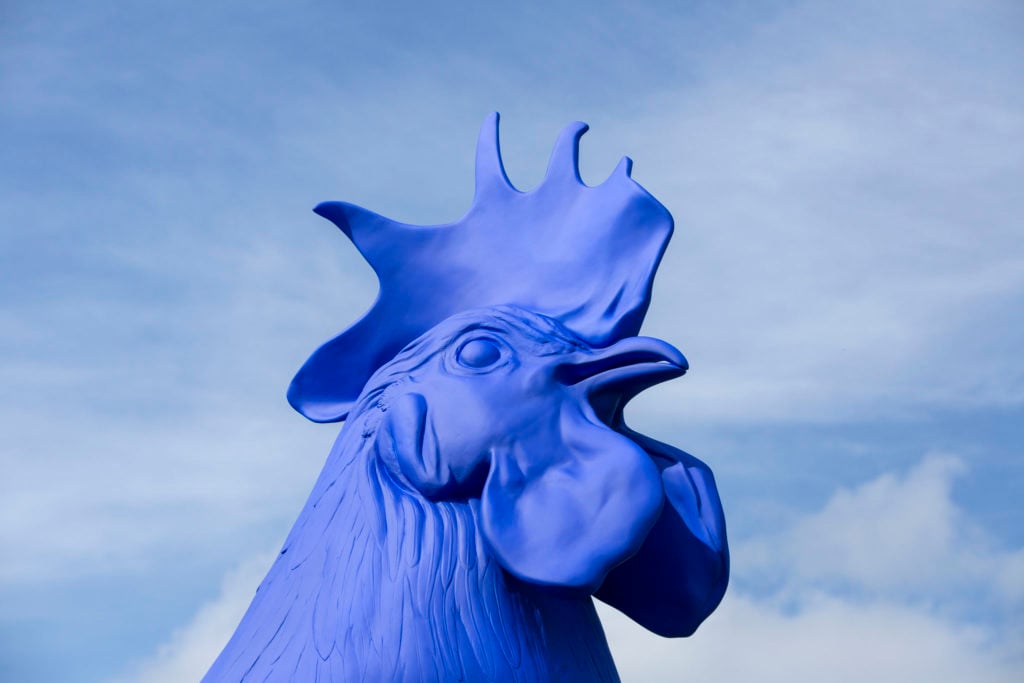
Concerns from the Native American community saw the opening delayed by a week.

Sarah Cascone

After being closed for over a year’s time, the beloved Minneapolis Sculpture Garden at the Walker Art Center is slated to finally welcome the public on June 10, 2017. The delayed reopening follows a massive renovation and expansion project, and the last-minute scrapping of a controversial sculpture.
At a press preview on May 23, Walker executive director Olga Viso’s biggest concern was the weather, as an unexpected series of rainy days meant that work was slightly behind schedule. Workers were scrambling to catch up, bright yellow construction vehicles leaving their tracks across patches of mud that would soon be verdant green lawns.
Less than a week later, the museum found itself plunged into a major PR crisis, responding to the concerns of the local Native American community. The Dakota nation was shocked to learn that Scaffold (2012), by Sam Durant, was a partial recreation of the gallows used to execute 38 tribe members in 1862. The killing, the largest mass execution ever held in the US, took place in nearby Mankato, Minnesota, and is still an open wound to many in the Native community.
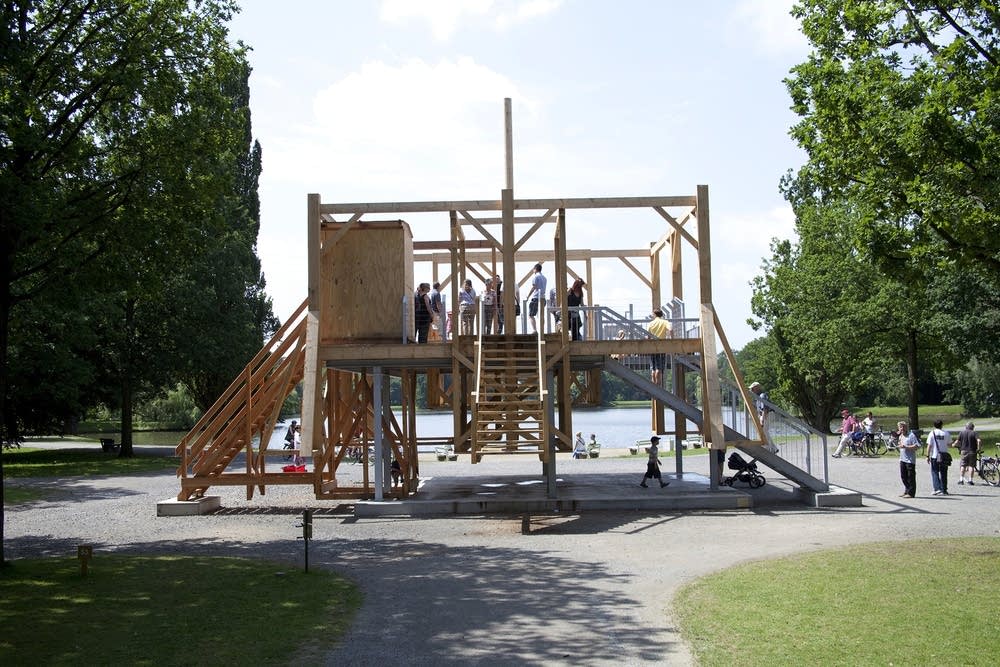
Sam Durant, Scaffold, 2012. Courtesy of the artist, Blum & Poe, Paula Cooper Gallery, Praz-Delavallade and Sadie Coles HQ. Photo by Rosa Maria Ruehling.
For Durant, the piece was a larger look at the country’s history of capital punishment, a composite of seven different gallows used in the hangings of abolitionist leader John Brown in 1859, deposed Iraqi president Saddam Hussein in 2006, and other historic executions.
For the Native American community, the work was a visual assault, an exploitation of their tragedy thoughtlessly presented among flashy, Instagram-baiting artworks.
The Walker had acquired the work after seeing it at Documenta 13 in Kassel, Germany. Viso tipped off the controversy by writing a blog post acknowledging that it had come to her attention that the piece might be upsetting, and that the museum should have opened a dialogue with the Native community before installing the work.
The museum, to its credit, was quick to respond to the concerns of the Dakota people, meeting with the tribal leaders and agreeing to dismantle the work. The original plan was to ceremonially burn the work’s wooden components, but the tribe is currently reevaluating their options. The Walker is leaving the final decision in the hands of the Dakota people.
Scaffold was one of 16 new works that have been acquired by the Walker for the garden. Since the garden’s inception in 1988, “there hasn’t been a major curatorial program to add to the garden,” says Viso. “We felt it was important to add new key works at a monumental scale,” and to “bring in a whole new generation of artists.”
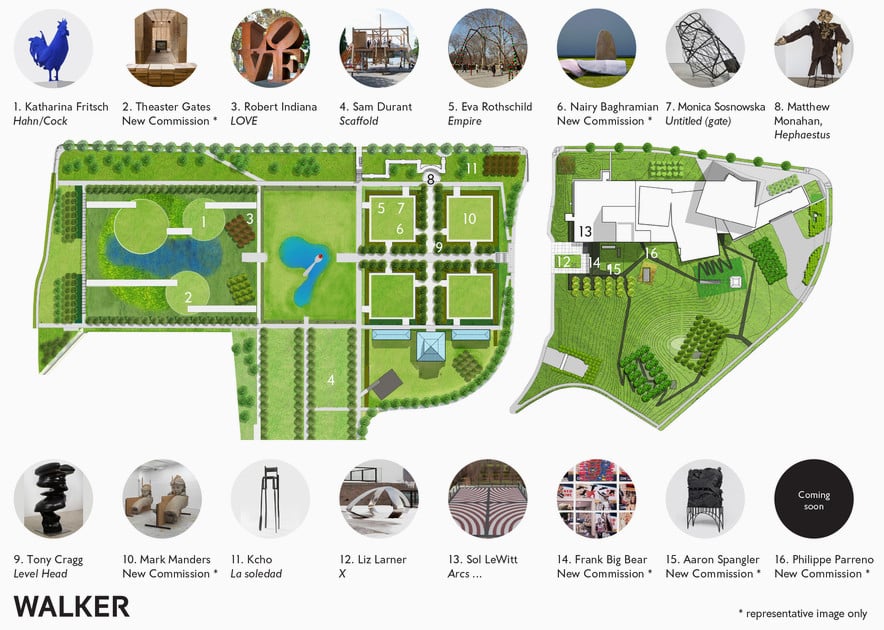
New additions to the Walker Art Center Campus and Minneapolis Sculpture Garden. Courtesy of the Walker Art Center.
Katharina Fritsch’s Hahn/Cock is perhaps the most high-profile addition to the grounds during the project. The 20-foot-tall rooster was originally commissioned in 2013 by the Fourth Plinth Commission, a project which each year taps one artist to create a work for London’s Trafalgar Square. There, the last of the square’s four pedestals, built in 1841, remained unadorned after the funds dried up for a planned equestrian statue of William IV, and has been used to display contemporary art since 1999.
At the Walker, the piece will sit atop a large pedestal designed by the artist specifically for the garden. Viso sees Hahn/Cock as a much needed centerpiece for the park’s northern section, which opened in 1992. “We needed something as dynamic as Spoonbridge and Cherry.”
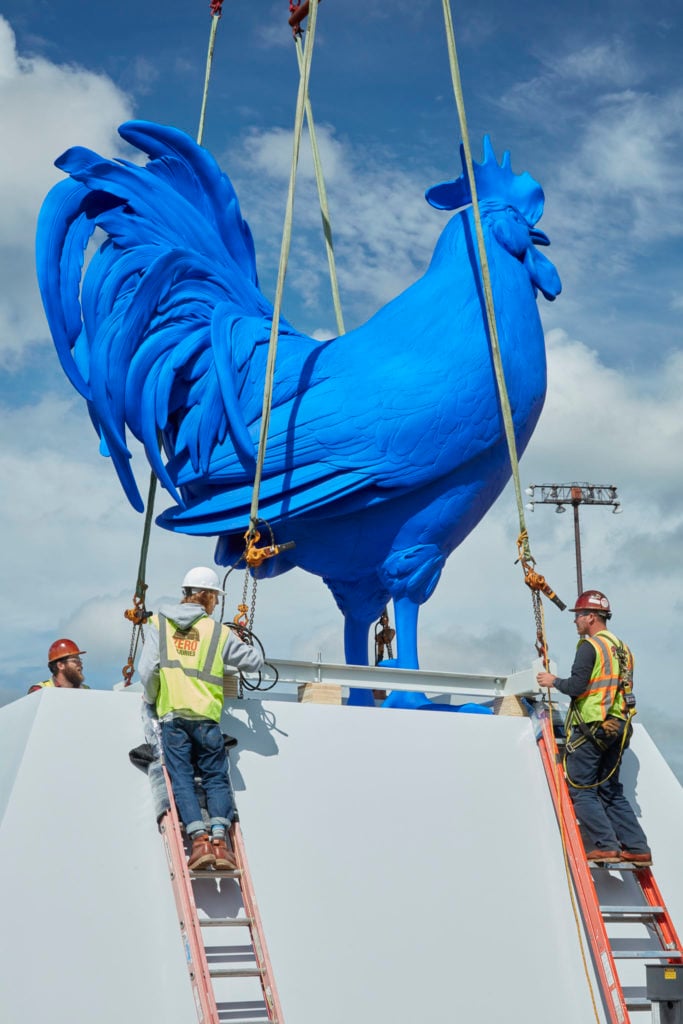
Minneapolis Sculpture Garden, Katharina Fritsch, Hahn/Cock being installed in the lower garden. Courtesy of the Walker Art Center/Gene Pittman.
She also enjoys the new context for the bright blue rooster statue, which appears to draw both on Minnesota’s historic poultry industry and the northern American folk legend of Paul Bunyan and Babe the Big Blue Ox. “Katharina knew nothing of those references,” Viso admits, but they nevertheless add to viewer’s appreciation of the work.
The original version of the piece was acquired by Glenstone, the private, Potomac, Maryland-based museum owned by collectors Mitchell and Emily Rales, and has been on display at the National Gallery of Art in Washington, DC, (where Rales is a board member) since the reopening of the museum’s I.M. Pei-designed East Building in summer 2016. The Walker’s version is the second in an edition of two by the artist, who is also the subject of “Katharina Fritsch: Multiples,” currently on view in the museum galleries.
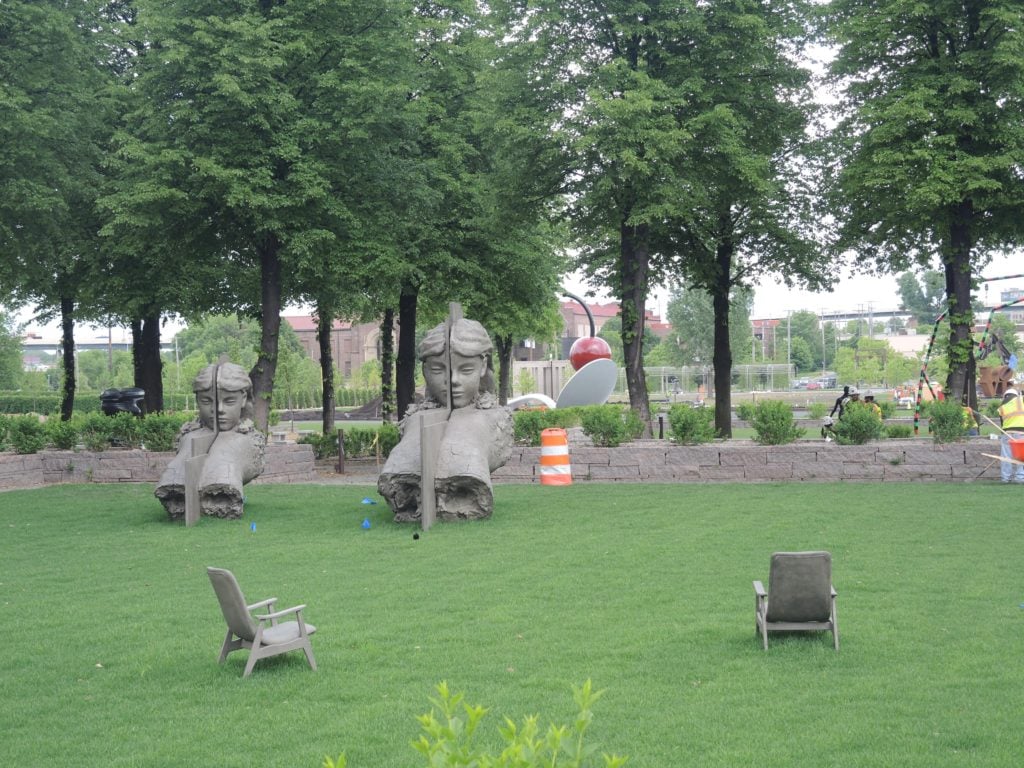
Mark Manders,
September Room (Room With Two Reclining Figures and Composition With Long Verticals), 2017. Courtesy of Sarah Cascone.
Other new works include commissions from Theaster Gates and Mark Manders, and Robert Indiana’s iconic LOVE (1966–98), an eight foot square made in Cor-Ten steel, which was one of 75 gifts given to the museum on the occasion of its 75th anniversary in 2015.
Viso remembers seeing Manders’s sculpture in the Dutch Pavilion at the 2013 Venice Biennale. “You could kind of tell he was looking to make bigger works, which was what inspired us to reach out to him.” The installation, titled September Room (Room With Two Reclining Figures and Composition With Long Verticals), is the first public artwork by Manders.
It is also the first permanent outdoor commission for Theaster Gates, who has found a permanent home for a statue of St. Laurence salvaged from a Chicago church in his piece Black Vessel for a Saint.
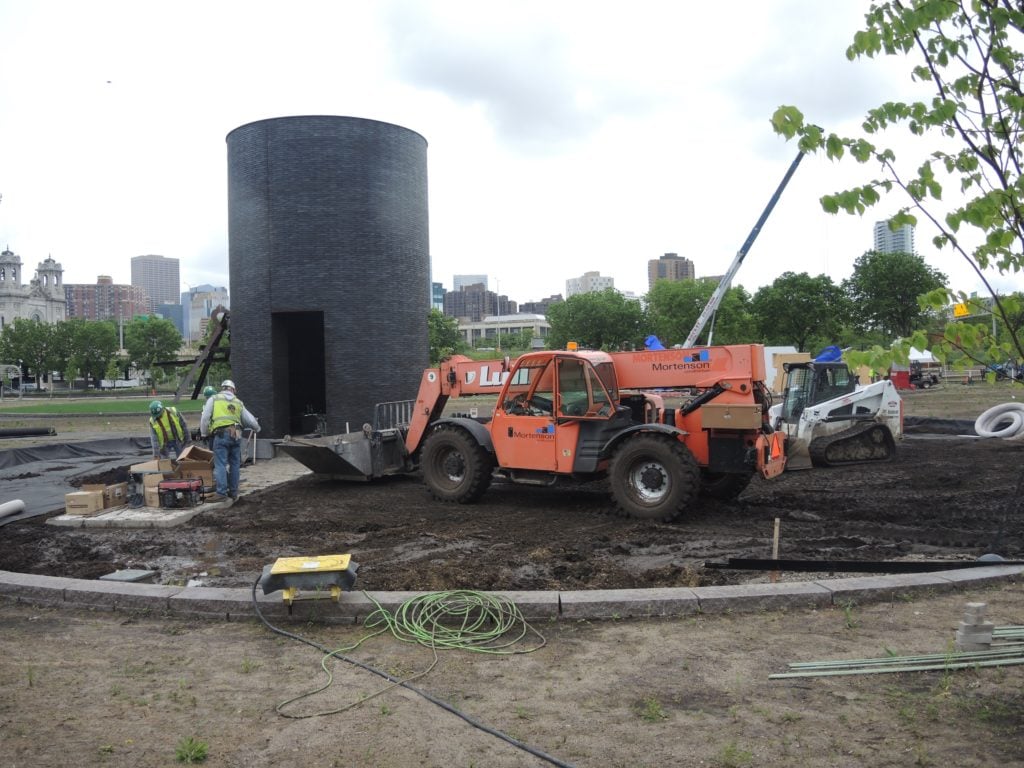
Theaster Gates, Black Vessel for a Saint being installed. Courtesy of Sarah Cascone.
Work on the grounds included renovating an aging irrigation system, carrying out conservation on all of the sculptures—there’s a fresh coat of paint on Claes Oldenburg and Coosje van Bruggen’s iconic Spoonbridge and Cherry—and transforming the garden’s greenhouse into an open air pavilion. The renovation plan endeavored to make the park more accessible and welcoming to visitors, removing fences, berms, and other barriers to entry.
“It’s open 365 days a year from dawn to dusk,” says Viso, noting that the garden has played host to 9 million visitors over the years and has become “a beloved space for all seasons,” despite the city’s harsh winters. (“Minnesotans are really hardy!” she adds.)
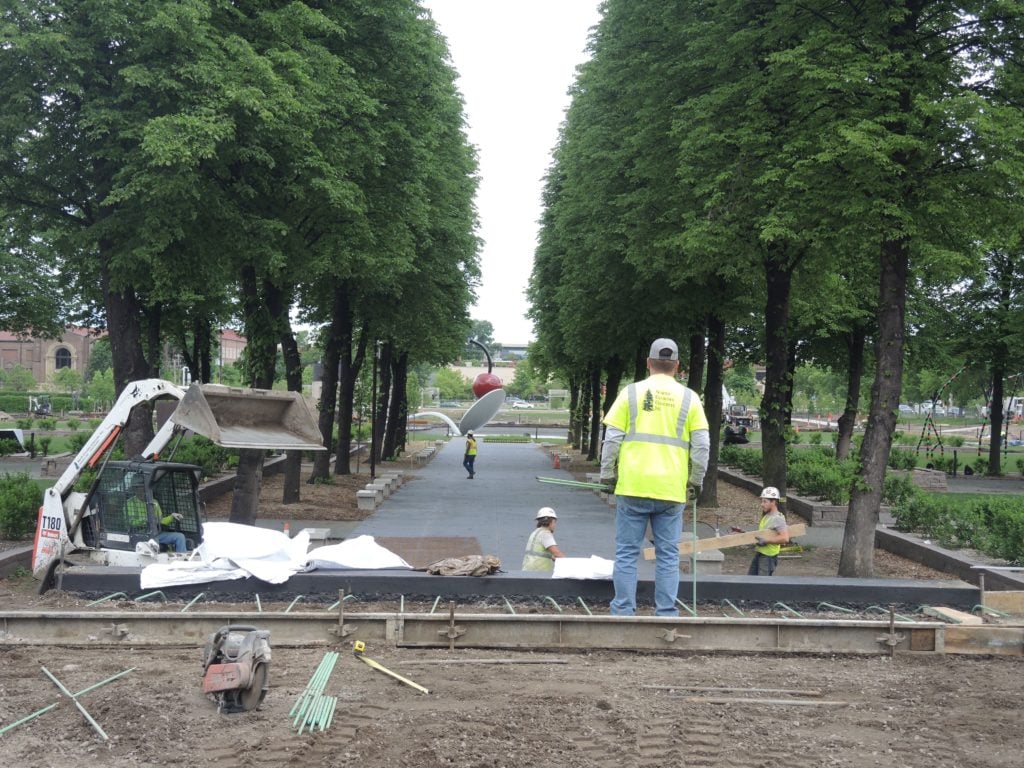
Construction at the Walker Art Center Campus and Minneapolis Sculpture Garden. Courtesy of Sarah Cascone.
Most importantly, the garden now transitions smoothly into the campus of the Walker, creating a unified 19-acre urban green space featuring a total of 56 statues.
Other major changes include the landscaping of the northern section, which is part of a natural flood plane and has tended to turn into a bit of a puddle after heavy rains. “Rather than try and fight it, as we have for the past 30 years,” says Viso, the landscaping team, working with the Mississippi Watershed Management Organization, has created three lawn-like “islands,” slightly raised areas for displaying sculpture, surrounded by a sea of tall grasses that will naturally transition into a wetland at various points in the year.
There are also plenty of new trees and foliage. “A lot of the plants were sort of nearing the end of their natural life cycles,” although the linden flowers lining the entryway are still going strong, says Viso, pointing out that “this was one of the first urban sculpture parks of its kind.”
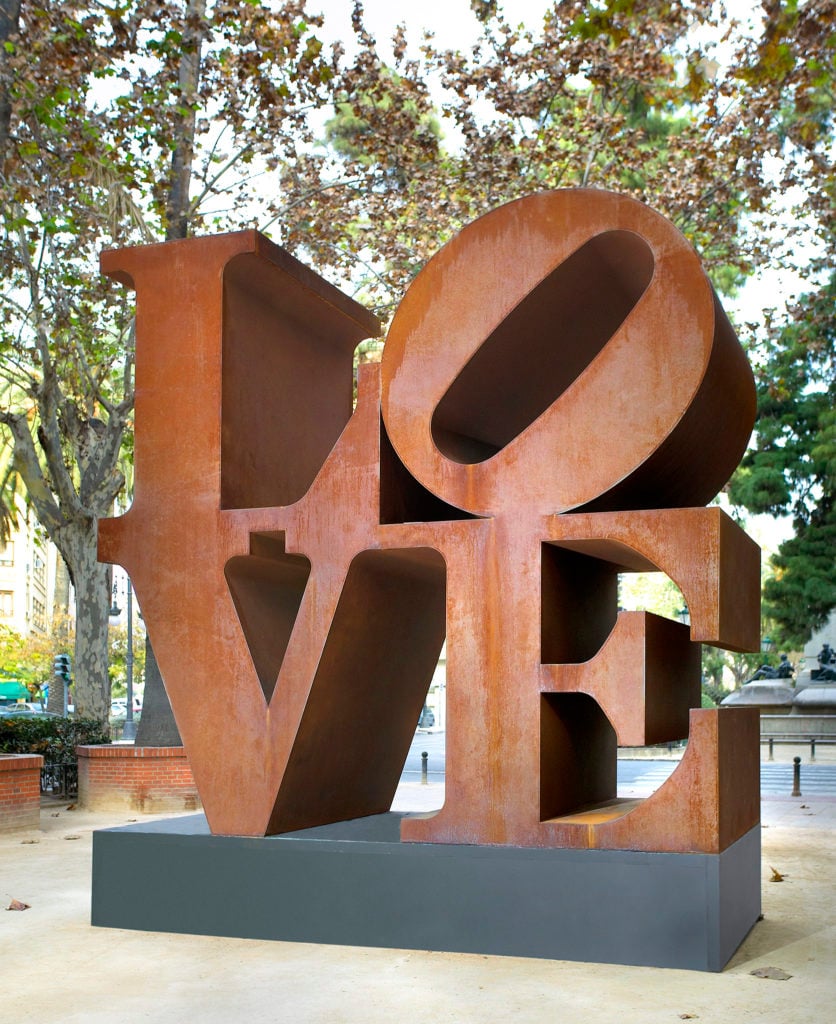
Robert Indiana, LOVE (1966–98) at the Walker Art Center Campus and Minneapolis Sculpture Garden. © Morgan Art Foundation, Artists Rights Society (ARS), New York.
Although some works will remain where they have been since the garden’s original opening, other areas have been reconfigured, giving visitors the chance to rediscover familiar pieces in new settings. Some old friends will no longer be on view of course, and are being loaned out.
This includes many of the earlier works from the 1940s and ’50s, such as Jacques Lipchitz’s Prometheus Strangling the Vulture II (1944/1953), which is currently on display at the Minneapolis Institute of Art. In its place is Matthew Monahan’s Hephaestus (2013), featuring the Greek god of blacksmiths. In the Greek myth, Prometheus was chained to the rock for stealing fire from Hephaestus’s forge, making the new work a “completely accidental” tribute to the one it replaced, says Viso.
Ahead of the groundbreaking, nearly all of the garden’s artworks were removed from the park (Spoonbridge and Cherry was among those that had to remain in situ for the duration of the work). Several were relocated to other public sites within the city or loaned to other institutions. For example, Mark di Suvero’s Molecule (1977–1983) will remain on long-term loan to Gold Medal Park, next to the Guthrie Theater in downtown Minneapolis.
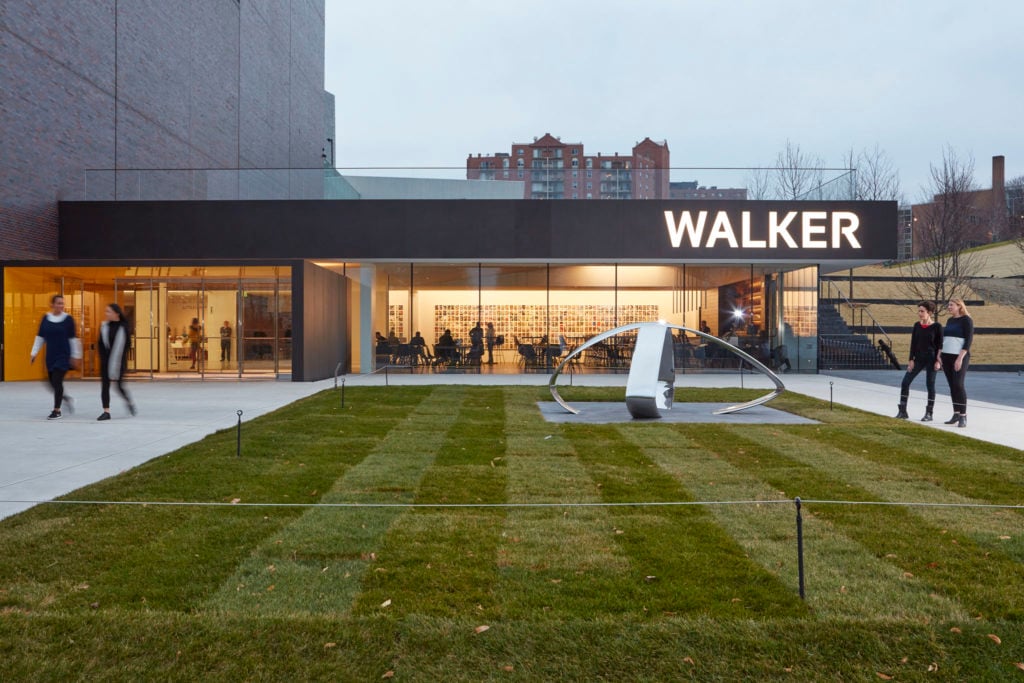
The Walker’s new entrance, with Liz Larner’s X, 2013. Courtesy of the Walker Art Center.
Until 2006, the Guthrie was located next door to the Walker. When that structure was torn down, it was replaced with an underground parking structure, but the landscape above—one of the city’s largest green roofs—remained unresolved and underutilized.
“The economy tanked, and we kind of took a pause,” Viso recalls. Now, the land, a gently sloping hill that offers a beautiful overlook of the rest of the park, is scattered with intimately scaled works and a grove of pine trees. A Liz Larner sculpture stands in front of the new entrance, directly opposite the garden.
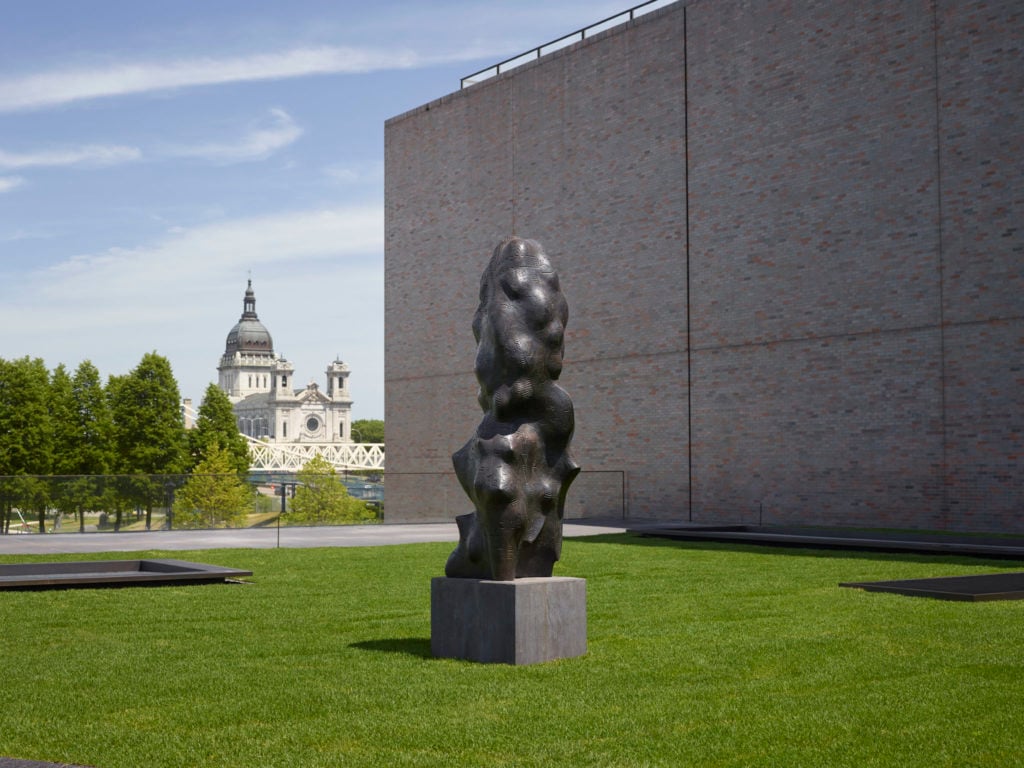
Aaron Spangler, Bog Walker, 2017. Courtesy of the Walker Art Center/Gene Pittman.
With the completion of the current project, this part of the Walker campus will become more integrated to the sculpture garden. An oft-overlooked James Turrell sky space, installed in 2005, and Danh Vo’s Tombstone for Phùng Vo, acquired in 2011, will be joined by new site-specific commissions from Nairy Baghramian, Philippe Parreno, and Aaron Spangler.
“We’re really focused on crossover attendance,” says Viso. “We want the contemporary art space to be as welcoming as the public outdoor space.”